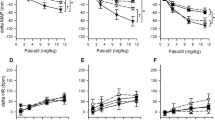Abstract
Avoidance conditioning sessions and isotonic saline (1.3 L/day) were administered to dogs for 12 days under conditions of a low (0.1%) or high (1.5%) calcium diet. Twenty-four-hour mean arterial pressure increased comparably during the stress-salt conditioning periods on both the low (systolic: +16 ± 5 mm Hg; diastolic: +6 ± 2 mm Hg) and high (systolic: +17 ± 4 mm Hg; diastolic: +11 ± 4 mm Hg) calcium diets. Urine volume, sodium excretion, and serum calcium levels on the high calcium diet were not significantly different from those on the low calcium diet. In a second experiment, calcium was infused continuously for six days into the arterial circulation of normotensive or stress-salt hypertensive dogs at a rate of 0.12–0.23 mEq/min. Although serum calcium levels increased by up to 50% under these conditions, there were no significant effects on 24-hour levels of arterial pressure. In contrast to the protective effect of augmented potassium intake, these findings indicate that calcium intake does not influence the development of stress-salt hypertension in dogs.
Similar content being viewed by others
References
Anderson, D. E. Behavioral conditioning and experimental hypertension. In Hypertension: Biobehavioral and Epidemiological Aspects,1981 Joint USA-USSR Symposium. Bethesda, MD, 1981.
Anderson, D. E. Behavioral determinants of experimental hypertension. In Field, T., Schneiderman, N., and McCabe, P. (Eds.),Stress and Coping. New York: Erlbaum, 1985.
Anderson, D. E. Operant conditioning, sodium loading and experimental hypertension.Journal of Cardiovascular Pharmacology, 1985 (in press).
Anderson, D. E., Kearns, W. D., and Better, W. E. Progressive hypertension in dogs by avoidance conditioning and saline infusion.Hypertension, 1983,5, 286–291.
Anderson, D. E., Kearns, W. D., and Worden, T. J. Potassium attenuates avoidance-saline hypertension in the dog.Hypertension, 1983,5, 414–419.
Ayachi, S. Increased dietary calcium lowers blood pressure in the spontaneously hypertensive rat.Metabolism, 1979,28, 1234–1238.
Bianchetti, M. G., Beretta-Piccoli, Weidman, P., Link, L., Boehringer, K., Ferrier, C., and Morton, J. J. Calcium and blood pressure regulation in normal and hypertensive subjects.Hypertension, 1983,5 (Suppl. II), II57-II65.
Furuta, Y., Omatsu, T., Kawahara, Y., Nishimura, Y., Hsieh, S., Saito, K., Yamanishi, J., and Oshima, T. Inhibitory effect of dietary calcium on sympathetic activities in DOCA/NaCl hypertensive rats.Circulation, 1984,70 (Suppl. II), 11–316.
Johannson, B. Processes involved in vascular smooth muscle contraction and relaxation.Circulation Research, 1978,43, 1–14.
Kearns, W. D., Better, W. E., Daley, L. A., and Anderson, D. E. A tether system for psychophysiological study of the dog.Behavioral Research Methods and Instrumentation, 1981,13, 323–327.
Lau, K., Zikos, D., Spirnak, J., and Eby, B. Evidence for an intestinal mechanism in hypercalciuria of spontaneously hypertensive rats.American Journal of Physiology, 1984,247 (Endocrinology and Metabolism: 10), E626-E633.
McCarron, D. A. Blood pressure and calcium balance in the Wistar-Kyoto rat.Life Sciences, 1982,30, 683–689.
McCarron, D. A. Calcium, magnesium and phosphorus balance in human and experimental hypertension.Hypertension, 1982,4 (Suppl. III), III27-III33.
McCarron, D. A., Morris, C. D., Henry, H. J., and Stanton, J. L. Blood pressure and nutrient intake in the United States.Science, 1984,224, 1392–1398.
Schlieffer, R., Pernot, F., Berthelot, A., and Gairard, A. Low calcium diet enhances development of hypertension in the spontaneously hypertensive rat.Clinical and Experimental Hypertension—Theory and Practice, 1984,A6(4), 783–793.
Stern, N., Lee, D., Silis, V., Beck, F., Deftos, L., Manolagas, S. C., and Sowers, J. R. Effects of high calcium intake on blood pressure and calcium metabolism in Young SHR.Hypertension, 1984,6, 639–646.
Wright, G. L., and Rankin, G. O. Concentrations of ionic and total calcium in plasma of four models of hypertension.American Journal of Physiology: Heart and Circulatory Physiology, 1982,243, H365-H370.
Author information
Authors and Affiliations
Additional information
Supported in part by a grant from the American Heart Association, Florida Affiliate, and grants #HL28462 and #HL01138 from the National Heart, Lung and Blood Institute.
Rights and permissions
About this article
Cite this article
Anderson, D.E., Murphy, P. & Kearns, W. High calcium intake does not prevent stress-salt hypertension in dogs. Pav. J. Biol. Sci. 21, 25–31 (1986). https://doi.org/10.1007/BF02995040
Issue Date:
DOI: https://doi.org/10.1007/BF02995040




